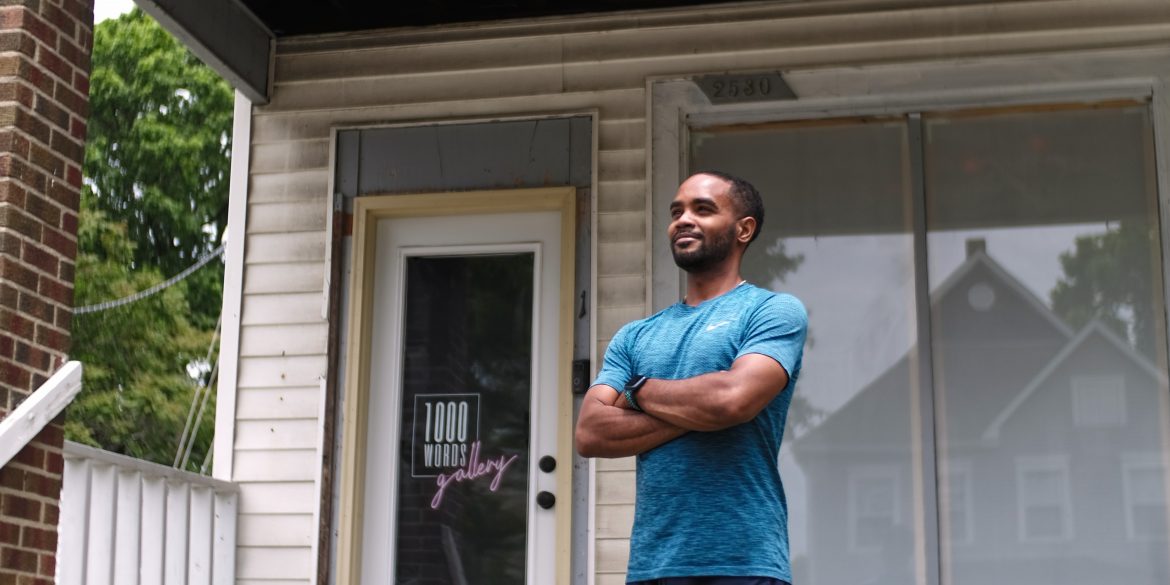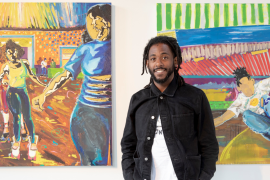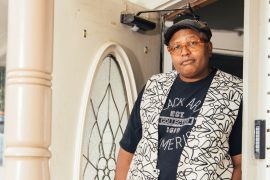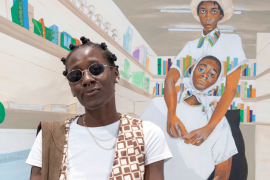1000 Words Gallery is a Black owned arts space located on the near Eastside of Indianapolis, striving to create a safe space to highlight the voices of it’s community. Throughout the pandemic, Midwest photographer and gallery owner, Chris Smith, was able to maintain the space and is now looking forward to showcasing the compelling work of Indy’s artist community. PATTERN was able to chat with Chris and discuss the past, present and future of the space. Read below to learn more about 1000 words Indy.
Khaila King: Can you tell me a little bit about yourself?
Chris Smith: I was born and raised in Cincinnati, OH. I graduated from University of Cincinnati in 2005 with an undergrad in education and then I went back for my masters in secondary education. I graduated in 2007. After college, I was a professional athlete for about 6 years until I suffered some injuries that ended my career and at that point I picked up photography. Actually videography first, but I wanted to make my videos look better so I started really diving deeper into how to make photos look a little bit more real, more colorful. Photography wise, I started doing shows and lectures in 2014 and I struggled to find a place to show my work consistently. When I moved to Indy in 2016 for work, it was always a dream of mine to have a place to show my work. That’s when I started my journey to open up 1000 words! It took a while, but it’s finally open. After being open for a year and going through the pandemic, it’s definitely taught me a lot about, not only my work, but trying to help other people get their work out there.
KK: When did 1000 words Indy get its feet off the ground and What prompted you to initiate a space like this?
CS: I signed the lease on Halloween of 2019 and in the summer of 2019, I was invited by 10 East Arts to display some of my photography during their Arts in the Park Series over the summer. It was an eight week series and every week I attended. There was a lot of engagement, especially from young people. They were really interested in how I produced the work and it got me thinking about how art has the ability to heal and be formative as well as educational. After that I got really serious about finding the location, I looked at quite a few places here on the east side, where I also live. I was able to find a building that was a symbol of the transition that was going on on 10th Street, and try to turn it from what it used to be in the recent past to an arts space for the future of our area. That’s when 1000 words became official. Then throughout the first part of 2020, before we got put on lockdown for the pandemic, that’s when I had my first set of shows. It was actually pretty cool to see friends from Fort Wayne, Ohio and Illinois come and check out the space. The pandemic made things kind of tough to meet in person. This year we’re looking forward to some exciting changes and hoping that we can pivot and make the arts space useful.
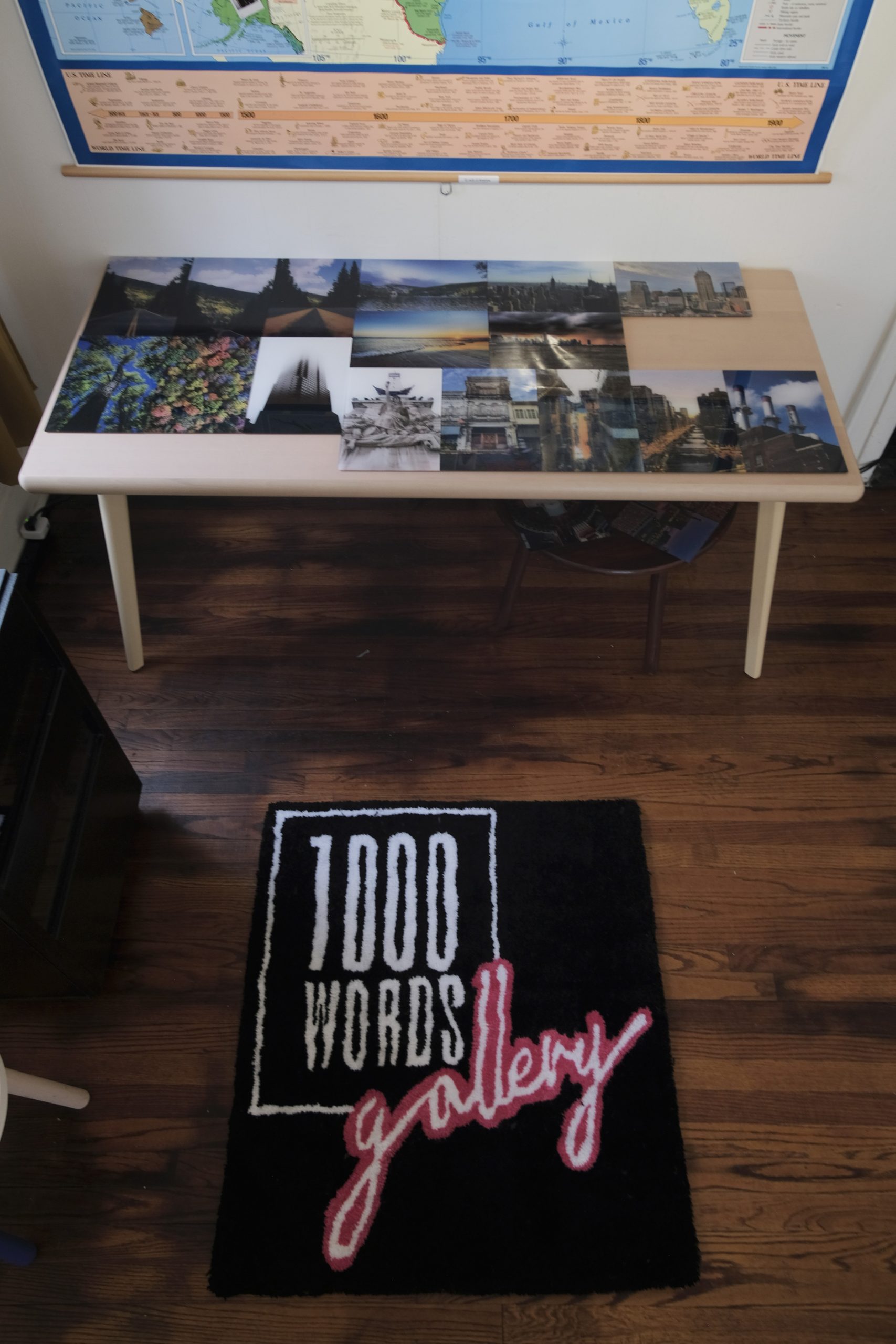
KK: Why do you believe a space like 1000 words Indy is necessary?
CS: I feel like when it comes to where it is and what it is, it’s an interesting convergence. It’s like the intersection of what used to be and what is going to be. I think that it’s really important that we reserve a space that’s safe for people to be able to express themselves artistically. Generally, when you’re in an area of rapid transition, a lot of low price homes are being purchased and turned into more market rate homes, making things a little bit more expensive. What tends to happen is only a certain type of people have access to the property, meaning that some of the viewpoints that were already pre existing in the area get washed away. My goal was to try to hold on to a space for the voices of the neighborhood, the youth of the neighborhood and the artists of the neighborhood. Art has a way of retelling and holding on to that story. I personally feel as if young Black artists from near and far in the city have a specific voice that needs to be heard. I feel like that’s the importance of maintaining 1000 words, as the Near East Side continues to grow and change.
KK: Can you tell me about the first show with Shade, what was the message behind it?
CS: Depending on how the show is, there can be things that interfere with the arts process. For example, if there’s a lot of music or a lot of alcohol flowing, sometimes the message of the art can get lost. However, I had the opportunity to go to a show of hers last year and she had some pieces that really cut through a lot of the noise. It touched me really emotionally and made me think about the intentionality of my own work. I was able to continue to follow her journey and connect with her early this year. We sat down and we had a meeting. I told her exactly what I just told you that regardless of what was going on around me, some of her work pulled me back to a different time and place and it really made me think more about what I was doing artistically and as a potential art gallery owner. She was very open about her process and how she feels as if she speaks for her ancestors. I think it was just that discussion of ancestry that made me want to make a place that was more open for her to tell her story right. Once we agreed on a time and a place, seeing the work that she brought in, it was even more confirmation for me that this place can be that voice or that space for the voice of young artists are also a reflection of what art has meant to us historically. There were probably over 100 people that came over the six days that she was here. It was extremely impactful not only to see her work, but also see how her work touched and inspired others. It was also a great opportunity for 1000 words to be introduced to a new crowd. I can’t say anything, except for glowing reviews. It was definitely the event we needed to be reestablished as a local art space.
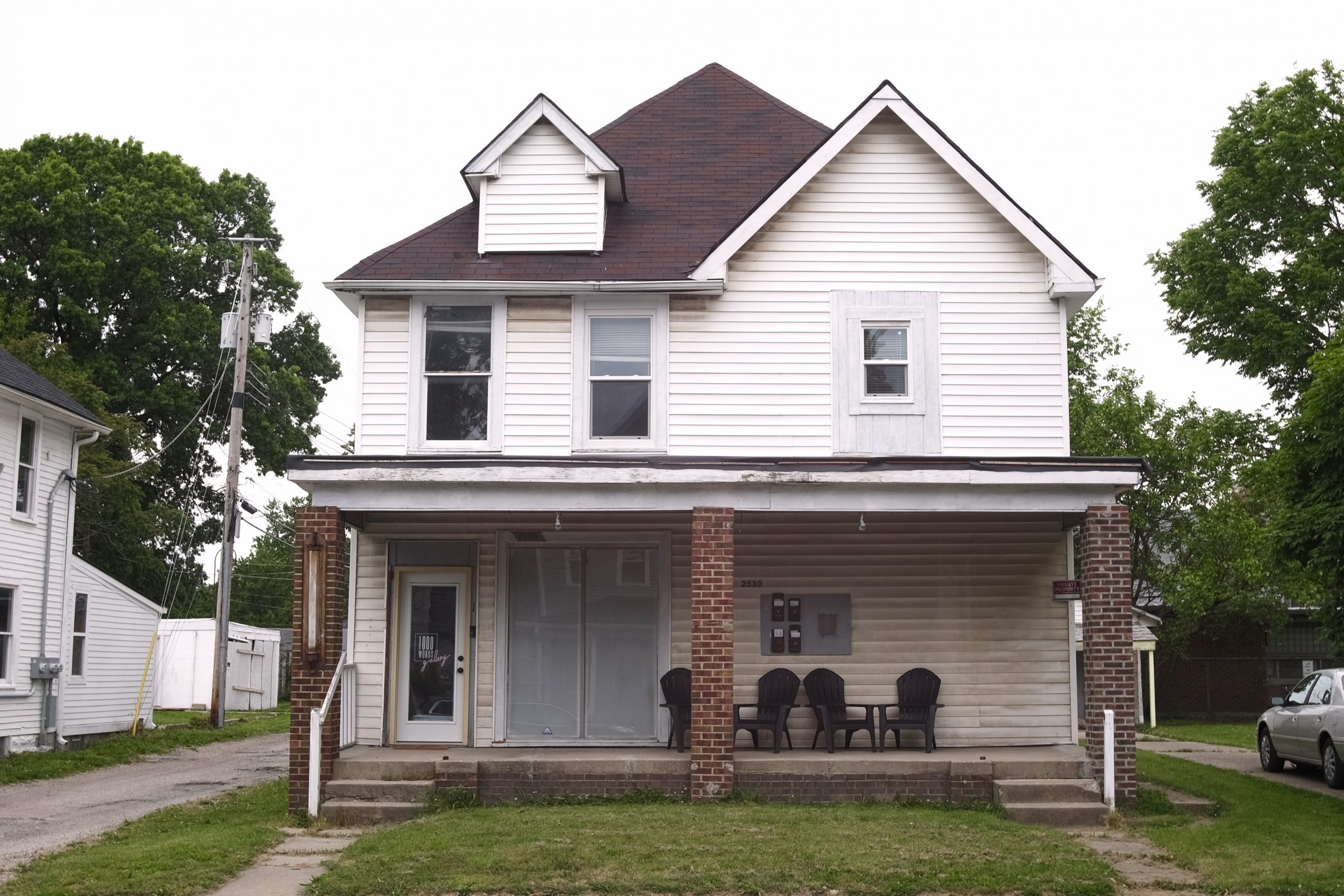
KK: Can you tell me about your photography show last month?
The work that we have now is from an idea I had called Stay Home. It was always a goal of mine to create the type of work that helps people who maybe don’t get the chance to travel to Thailand or outside of their neighborhood in Indy, the ability to feel what I felt when I took some of those photos. There’s small format photos on acrylic and I feel as if I really tried to get people back into that travel mindset even though we really can’t go anywhere right now. It’s definitely a new way for me to try to tell a story through places so that’s what you get right now is stay home. We had a pretty decent showing for, you know, just from my work in terms of people that I showed up to support it.
KK: What are you looking for in a creative to host a show there? How do you source creatives?
CS: Right now, it’s about getting to know the artist community. It’s going to other shows and seeing what type of artists are there and who’s along that journey of, “I want to show my work and sell it.” I think it’s really important that people understand how selling art works and how showing artworks, but I also don’t think that means that you have to be experienced. My goal is to introduce artists who are on the cusp of saying, “hey, I’ve got work I’m confident in and I want to show it,” to a stage to stand on. Sometimes that means helping artists photograph their work and digitize it for online sales. Sometimes that’s just helping the artist understand marketing and how to attract new customers. Sometimes it’s literally telling the artist how to connect with the people, the patrons who are coming to their work and actually get some sales out of the show. What I look for in the creative really is confidence. I really want to support them in their journey. Most people get the idea that there’s a lot of rules, or there’s a lot of prerequisites that are required to show your work and I totally disagree with that. I think that the only thing that a creative has to do is remain creative and make things. As long as they’re making stuff and ready to show it, that’s what we’re here for.
KK: What are some of the challenges you’ve faced trying to maintain a space?
CS: I would say the biggest challenge, obviously, has been the COVID pandemic. I really had to think deeply about what it was that I wanted to accomplish with the space or if the space could even be maintained, without any real business coming in. Thanks to a lot of arts organizations on the Near East Side, like 10 East Arts and The Bonner Center, I was able to find some funding to add to the self funding I’ve been doing since 2019 to keep the lights on and keep the doors open. The biggest challenge right now is trying to fund the space, but I think I’ve been lucky enough to be able to make that work since we’ve been open. I know that it’s an investment for the future. I’m confident that someday, we will be able to be fully funded and to be able to support as many artists as possible. What I would tell anybody that’s interested in being an artist, or hosting a space for artists, is that especially when you are trying to market the art to young people, you just have to understand what their capacity to pay for art is and to support the space. I try to make things very accessible. I really encourage artists to have prints. Everybody wants to own art, but sometimes they can’t pay the price for some of the larger pieces or some of the more expensive pieces. Just making our overall accessible has been what I’ve learned from those challenges. Every day, this interview for example, doing TV interviews, whatever I can do to keep the space relevant, those are things that hopefully will help me overcome the challenge of funding and what the pandemic has kind of created in terms of a barrier.
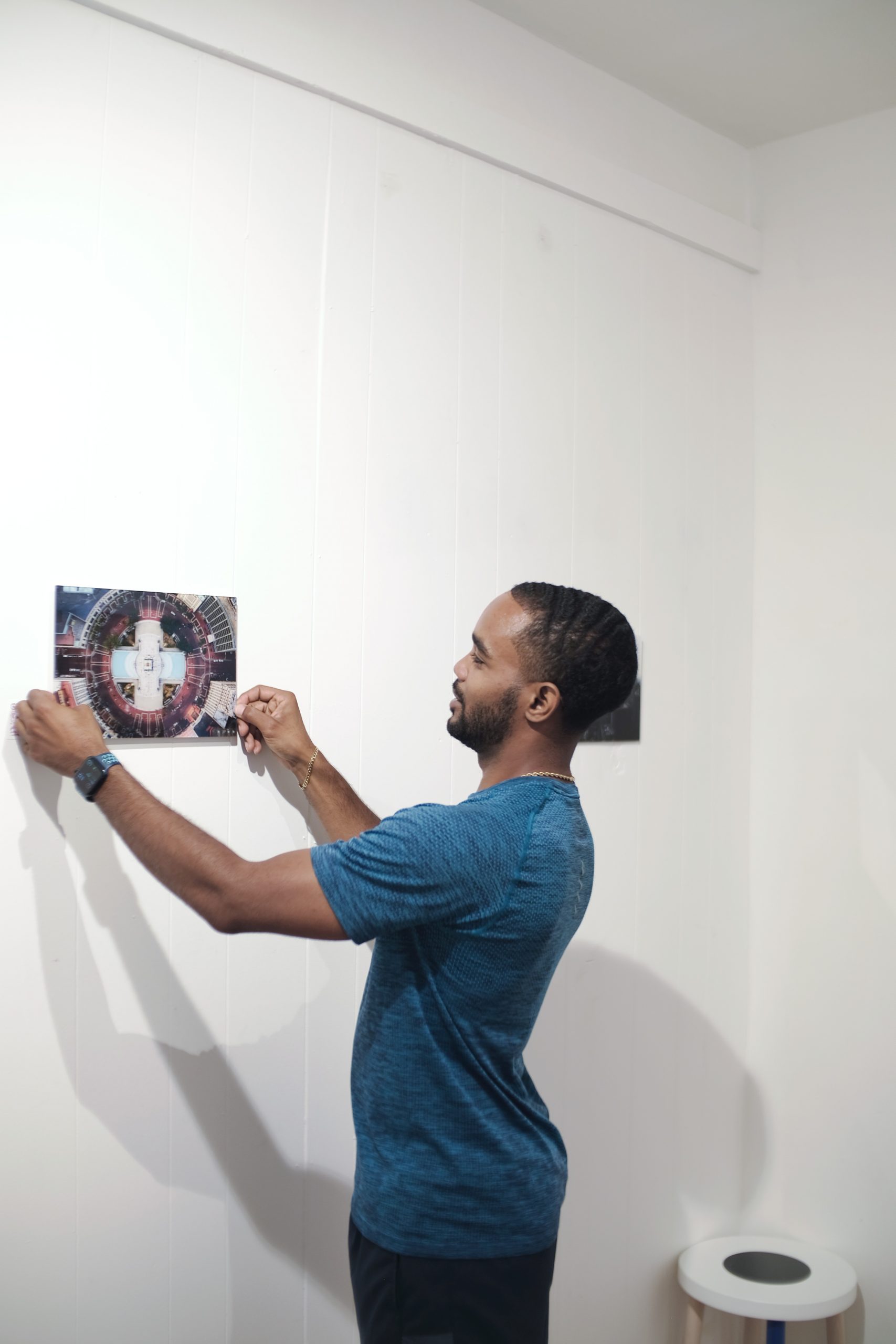
KK: What are the strengths and areas of opportunity for the creative community of Indianapolis?
CS: In terms of strengths there seems to be a lot of cohesiveness. Things are very organized and communal in a sense. I’ve seen a lot of artists working together when I go to different shows or seeing different murals projects. I see other artists there supporting each other, which has been great, because it’s been a way for me to connect with the art community here. I think the areas of opportunity really rely around trust, and building a sense of openness. I’m not really from here. I know other artists have commented on this as well. Because it is such a tight knit community, outsiders such as myself, might find it more challenging to be a part of that. For example, if someone came from Cincinnati to do a show that artists here would support, and if artists here wanted to go to Cincinnati, you have that pipeline, it creates sharing and openness. That opportunity to create a more symbiotic space where we can all help each other out, I think that’s where we need to go next, however, as a new person to the city and as a new space, I’m always open to see where the opportunities are. I also understand I have a blind spot and I just want to be able to continue to connect with artists and understand what those opportunities are.
KK: How would you like to be a part of that area of improvement?
CS: It’s definitely a lot tougher, when you say those things out loud and then have to turn them into actions. I really want to be open and accepting of different ideas, different artists, different styles of work. I don’t want to make people feel as if, “Oh, I can’t do this or that, because it’s this kind of gallery.” As long as it’s art, you’re doing creation that can, you know, tell your story. Our goal is to give you a platform to do that. I also try my best to spread the word about arts, in the community where I feel like it may be underserved. If I see new artists that are coming up and they have great work, it’s always a thing of mine to get my friends, my family and other people who follow the gallery interested in the art of new and emerging artists. I know I’ve got a lot of work to do personally, to make this the space what I want it to be. I am open to criticism and understanding how I fit into the community helps me continue to evolve, and make sure that I’m supporting the things I say I want to support.
KK: What should we expect to see from the gallery this year?
CA: Hopefully, you get to see a lot of great Black art. That’s my goal. You know, I know that there is a pretty tight knit community, but I hope to continue to give artists a platform to show their work, sell their work and learn more about art in general. I hope you see lots of action on 10th Street, lots of improvements to our area, but mostly, I hope you see our area become known for a place where you could come to see great artwork.

